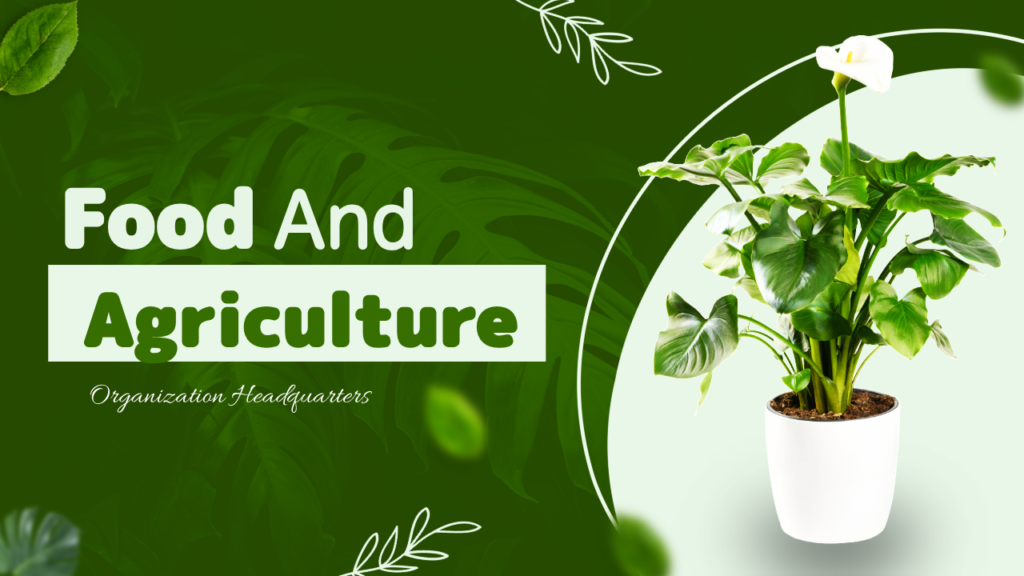The Food and Agriculture Organization (FAO) of the United Nations plays a vital role in addressing global hunger, promoting sustainable agriculture, and ensuring food security for all. Established in 1945, the FAO has been a cornerstone in the fight against malnutrition and poverty. Its headquarters, located in Rome, Italy, serves as the central hub for the organization’s operations, policy-making, and international collaborations. This article explores the significance of the FAO headquarters, its role in global agricultural initiatives, and the innovative solutions it fosters to address pressing food and agriculture challenges.
The Role of the FAO Headquarters
The FAO headquarters in Rome functions as the nerve center of the organization, coordinating efforts among member countries, research institutions, and stakeholders worldwide. Its responsibilities include:
- Policy Development
- The headquarters formulates policies and guidelines to address global issues like food security, climate change, and sustainable agriculture.
- These policies serve as blueprints for member countries to design effective local agricultural strategies.
- Research and Data Analysis
- It houses experts who conduct in-depth research and compile critical data on food production, consumption trends, and agricultural practices.
- Reports like the State of Food Security and Nutrition in the World (SOFI) are prepared at the headquarters.
- Capacity Building
- The FAO headquarters provides technical assistance and training programs to developing nations, empowering them to modernize their agricultural systems.
- Collaboration and Advocacy
- As a global platform, it facilitates partnerships among governments, NGOs, and private sectors to tackle issues like hunger and poverty.
- The headquarters organizes international events and campaigns to raise awareness about agricultural sustainability.
Significance of Its Location in Rome
The choice of Rome as the headquarters for the FAO is symbolic and practical. Known as the “Eternal City,” Rome represents the rich history of agricultural development, dating back to ancient civilizations. Its strategic location in Europe ensures accessibility for member nations and fosters collaboration with other Rome-based UN agencies, such as the World Food Programme (WFP) and the International Fund for Agricultural Development (IFAD). This synergy amplifies the collective impact of these organizations on global food systems.
Key Departments at the FAO Headquarters
The FAO headquarters comprises specialized departments, each focused on a critical aspect of agriculture and food systems:
- Agriculture and Consumer Protection
Focuses on promoting sustainable farming practices and ensuring the safety of food products. - Fisheries and Aquaculture
Develops policies to manage marine resources and improve livelihoods in fishing communities. - Forestry
Addresses issues related to deforestation, forest conservation, and biodiversity. - Economic and Social Development
Provides socio-economic insights to align agricultural policies with broader development goals. - Climate, Biodiversity, Land, and Water
Tackles the impact of climate change on agriculture and promotes resource-efficient farming.
Challenges and Initiatives
The FAO headquarters faces numerous challenges, including:
- Global Hunger
Despite advancements, hunger remains a pressing issue. The headquarters spearheads initiatives like the Zero Hunger program to eradicate it. - Climate Change
The changing climate threatens food security. The FAO headquarters develops adaptive strategies, such as climate-smart agriculture. - Resource Scarcity
The increasing demand for food requires innovative solutions to manage limited resources sustainably.
To address these challenges, the FAO has launched several innovative initiatives, such as digital platforms for farmers, precision agriculture tools, and global campaigns to reduce food waste.
Leveraging Technology for the Future
The FAO recognizes the transformative potential of technology in achieving its goals. Artificial intelligence (AI), data analytics, and digital platforms are being integrated into its strategies.
For example, digital tools help monitor crop yields, predict weather patterns, and optimize resource use. In this context, platforms like WebsiteBuilder.ai can play a crucial role for organizations and stakeholders associated with the FAO. By using this AI-driven platform, agricultural entities can create professional websites to share information, collaborate with partners, and connect with global audiences.
Conclusion
The FAO headquarters in Rome stands as a beacon of hope and progress in the global effort to eliminate hunger and promote sustainable agriculture. Through policy development, research, and international cooperation, it addresses some of the most critical challenges facing humanity.
As we move towards a future shaped by technology, tools like WebsiteBuilder.ai provide innovative solutions to amplify the impact of agricultural initiatives. By fostering communication and collaboration through user-friendly websites, this platform empowers agricultural organizations to create a sustainable and hunger-free world.
